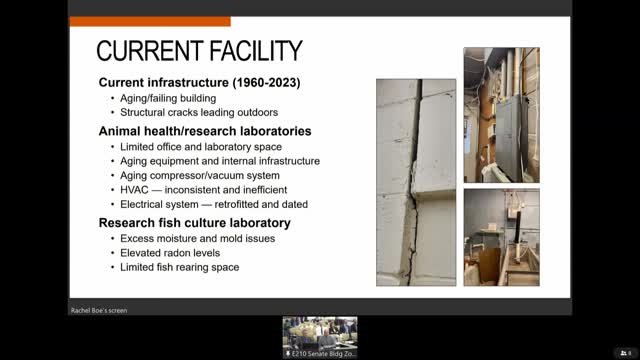Officials outline $16 million plan for new fish-health lab, say construction could start if funded
January 28, 2025 | 2025 Utah Legislature, Utah Legislature, Utah Legislative Branch, Utah
This article was created by AI summarizing key points discussed. AI makes mistakes, so for full details and context, please refer to the video of the full meeting. Please report any errors so we can fix them. Report an error »

A presenter to a Utah legislative committee described plans for a new 11,000-square-foot fish-health laboratory and adjacent office space and said the project would cost just under $16 million and could begin construction immediately if full funding and approvals were in place.
The project, the presenter said, sits on 3.1 acres acquired in 2021 through a property trade with Logan City. The project team has developed a five-year master plan (initiated in 2017), completed a 2021 feasibility study and updated construction-cost estimates in 2022. The presenter told the committee the design includes laboratory space, offices, well development for a wet lab and demolition of an old building to free room for hatchery expansion.
The plan calls for roughly 11,000 square feet of new construction at a total project cost “just under $16,000,000,” the presenter said, with about $11,000,000 attributed to construction and nearly $5,000,000 to soft costs. Other identified costs include site preparation, utility connection fees, hazardous‑material abatement and well development for the wet lab. The presenter said temporary housing would be provided via two RV pads on the property to help recruit staff.
The presenter said the team had coordinated with the Department of Natural Resources and the Division of Wildlife Resources to move the project higher on the priority list and to ensure utilities and approvals would allow work to begin quickly if funding is approved.
During public questioning, Representative Kristofferson asked whether the state hatchery program competes with private fish growers and whether the state provides services to private fisheries. The presenter said Utah’s Fish Health Policy Board provides a forum to work with private growers and that private operations generally rely on private veterinarians for services. The presenter added that while the state once oversaw fish‑health testing for private aquaculture, those responsibilities were transferred to the Department of Agriculture years ago.
A committee member asked for a comparison of the state program’s “cost per fish” to private-sector costs. The presenter said those specific figures were not on hand, but that cost data from the Division of Wildlife and private growers could be made available.
No committee vote or formal recommendation on the lab project was recorded in the transcript; the presenter offered to provide further information and answer additional questions.
The project, the presenter said, sits on 3.1 acres acquired in 2021 through a property trade with Logan City. The project team has developed a five-year master plan (initiated in 2017), completed a 2021 feasibility study and updated construction-cost estimates in 2022. The presenter told the committee the design includes laboratory space, offices, well development for a wet lab and demolition of an old building to free room for hatchery expansion.
The plan calls for roughly 11,000 square feet of new construction at a total project cost “just under $16,000,000,” the presenter said, with about $11,000,000 attributed to construction and nearly $5,000,000 to soft costs. Other identified costs include site preparation, utility connection fees, hazardous‑material abatement and well development for the wet lab. The presenter said temporary housing would be provided via two RV pads on the property to help recruit staff.
The presenter said the team had coordinated with the Department of Natural Resources and the Division of Wildlife Resources to move the project higher on the priority list and to ensure utilities and approvals would allow work to begin quickly if funding is approved.
During public questioning, Representative Kristofferson asked whether the state hatchery program competes with private fish growers and whether the state provides services to private fisheries. The presenter said Utah’s Fish Health Policy Board provides a forum to work with private growers and that private operations generally rely on private veterinarians for services. The presenter added that while the state once oversaw fish‑health testing for private aquaculture, those responsibilities were transferred to the Department of Agriculture years ago.
A committee member asked for a comparison of the state program’s “cost per fish” to private-sector costs. The presenter said those specific figures were not on hand, but that cost data from the Division of Wildlife and private growers could be made available.
No committee vote or formal recommendation on the lab project was recorded in the transcript; the presenter offered to provide further information and answer additional questions.
View full meeting
This article is based on a recent meeting—watch the full video and explore the complete transcript for deeper insights into the discussion.
View full meeting

